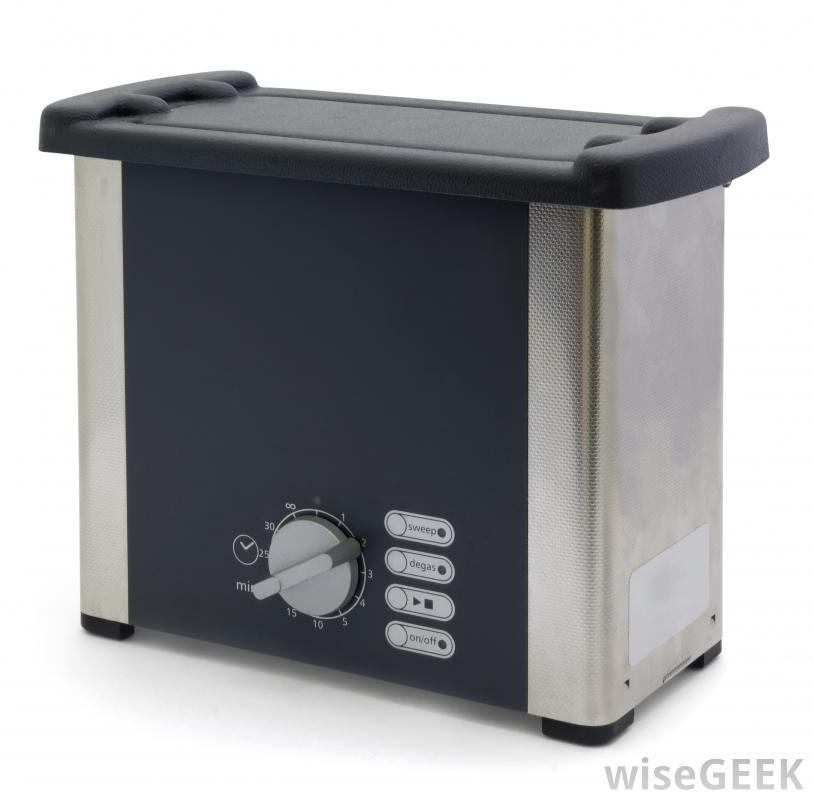
An ultrasonic jewelry cleaner is an electronic appliance designed to quickly and easily remove dirt, debris, and surface stains from most types of jewelry. It relies on ultrasonic energy and sound waves to force liquid cleanser into cracks and crevices between stones and in settings, and can polish the outer surface of most metals, too. Most professional jewelers have these sorts of machines, and many industrial models have the capacity to clean a number of pieces at once. In many places it’s also possible to buy smaller versions for individual home use. Owners need to understand which sorts of cleansing fluids to use and how to turn the machine on and off, but in most cases this is about the extent of it. The machines are generally very easy to use and clean, though some upkeep is required to keep them performing optimally.
Most cleaners look like sealed tanks or closed boxes, and most can sit on top of a table or counter top. They consist of a small transducer, which works like a motor; an empty chamber that users fill with fluid; and an insert basket where the jewelry needing cleaning is placed. The basket submerges the jewelry but doesn’t allow it to touch the bottom or float freely. Any dirt or debris that comes off falls to the bottom where it can be cleaned out later, and the jewels are left soaking at the top.

The main role of the transducer is to produce ultrasonic energy that bounces around the cleaning chamber. This sort of energy travels by sound waves and is very powerful. It also tends to bounce off of metals and other hard, non-porous materials like diamonds and most precious gems. Using ultrasonic energy is a lot more effective than just soaking dirty jewels or scrubbing them by hand, since the sound waves can get in between even very tiny grooves and can eliminate dirt on a microscopic level.
On average, ultrasonic jewelry cleaners emit at least 40,000 sound waves per second. The resulting vibrating motion creates microscopic bubbles in the water or cleaning solution in a process called cavitation, during which millions of tiny bubbles knock into one another and into the items resting in the insert basket. The cavitation process gently knocks dirt off the jewelry all while barely touching it. Provided the machine is built properly, the waves, while very powerful, will not actually leave the cleaning chamber and don’t pose any sort of risk.
Ultrasonic jewelry cleaners tend to be pretty expensive, and they’re mostly used by people who need to do a lot of cleaning every day. Professional jewelers, estate agents, and auctioneers are some of the people who might be interested in an industrial grade device. Most of these tend to be somewhat large, and often have the capacity to clean many different pieces at once. Most have different settings when it comes to temperature and clean time.
Smaller models that can clean only a single bracelet, ring, or necklace before needing to be reset are sometimes often available. These are popular with people who have a lot of jewelry needing cleaning on a regular basis. Celebrities, public figures, and the wealthy elite are some of the most common purchasers of these sorts of “use at home” devices, though they’re available to the general public, too. People sometimes also use these sorts of devices to clean other things like eyeglasses that have a lot of grooves and crevices.
Success with an ultrasonic jewelry cleaner usually depends on two main factors: using the proper cleaning fluid and paying attention to what sort of jewels are being soaked. Most machines will work with little more than warm water, but the results are often better with some more aggressive cleaning fluid, particularly if there’s a lot of dirt. Most experts recommend a non-ionic surfactant, detergent, or ammonia. Cleaning agents with bleach and acids should generally be avoided since these can harm even very resilient metals.
Not all jewelry is suitable for cleaning in one of these sorts of devices. Most manufacturers do notrecommend exposing opals, pearls, emeralds, coral, or other soft materials to ultrasonic waves since the waves could actually penetrate the surface of these substances and could cause them to erode or weaken. Ultrasonic cleaning generally works best on hard stones set in gold or platinum.
People usually also need to be careful to regularly clean their devices, and to drain them completely between uses. Standing water, even water that is mainly a cleaning fluid, can harbor bacteria. Chemical deposits or residues can also clog the transducer ports, which can limit the ability of the ultrasonic waves to get into the chamber in the first place.